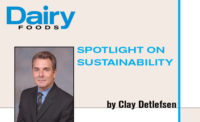In 2008, the dairy industry made a voluntary commitment to reduce greenhouse gas (GHG) emissions by 25% by 2020 – a lofty goal, to say the least. In fact, it is remarkable to think how far we have already come since 1944.
Research published in the Journal of Animal Science shows the carbon footprint of a glass of milk was 63% lower in 2007 than in 1944. Based on the Innovation Center for U.S. Dairy’s “Carbon and Water Life Cycle Assessment for U.S. Milk,” the carbon footprint of 1 gallon of fluid milk consumed today is 17.6 pounds of CO2 equivalent, the globally recognized method of GHG reporting.
The entire U.S. dairy industry’s carbon footprint, from farm to manufacturer, is 137 million metric tons (MMT), or just shy of 2% of total U.S. GHG emissions. Of that, 35 MMT was associated with fluid milk, 54 MMT with cheese and whey, and 48 MMT for all other dairy products. The key to further reducing our GHG emissions is to focus on optimized efficiency for all segments of the dairy industry, including increasing milk yield per cow, reducing enteric emissions, improving manure handling, optimizing breeding and enhancing cow comfort.
Tools for dairy processors, producers
The goal of 25% reduction applies to the entire dairy chain, from the farm all the way to the table. Depending upon which segment of the industry you are in, there are a number of tools and programs to help achieve sustainability goals and then to communicate successes after the goals are met.
For example, if you are a dairy processor, you should know a processor-led team is working with the Innovation Center and International Dairy Foods Association (IDFA) to develop a Processor Handbook with guidance for metric calculations. And, information on best practices and case studies related to energy efficiency in plants can be found at EnergyStar.gov and at USDairy.com/Sustainability/AtThePlant. If you are involved with dairy transportation, you can learn how to measure, benchmark and increase transportation efficiency at epa.gov/SmartWay. Further you can visit USDairy.com/OnTheRoad for case studies and communication tips.
Focus first on fluid milk
Given that slightly over 70% of fluid milk’s carbon footprint is associated with milk and feed production, it is imperative to focus on this segment of the dairy industry. To that end, the Innovation Center created Farm Smart as an integrated online management tool that helps dairy producers evaluate their production techniques, assess economic and environmental consequences of potential improvements in management practices, and share the contributions of their farms to neighbors, community groups and consumers. The system included feed and energy modules to quickly assess a farm’s forage and energy systems, and create a financial snapshot of current practices. Using the baselines, farmers can then explore alternative practices to improve their farm operations and demonstrate their ongoing commitment to environmental stewardship and continuous improvement.
In July, the National Milk Producers Federation and the Innovation Center announced they would integrate Farm Smart into the Farmers Assuring Responsible Management (FARM) Program as a GHG assessment tool, formally calling it FARM Environmental Stewardship. This voluntary module will assist companies that want to show the continued progress dairy farmers are making in reducing GHG emissions and easing the burden of data collection. FARM Environmental Stewardship is scheduled for launch in January 2017.
As mentioned above, once you have embraced sustainability and have achieved actual improvements, you need to best understand how and what to communicate. To facilitate that, the Innovation Center in conjunction with industry stakeholders recently released its updated Stewardship and Sustainability Framework for U.S. Dairy (Framework), to help voluntarily communicate dairy sustainability in a credible manner. The Framework is a guidebook to help communicate sustainability actions and is intended to support dairy cooperatives, processors, manufacturers and milk marketing organizations.
Retailers and other U.S. dairy customers can use the Framework to track their suppliers’ continuous improvement on the sustainability measures that matter most. As time progresses the Framework will be updated regularly to reflect the latest scientific information and generally accepted best practices.
The Framework contains the typical metrics you would expect to see, like total energy or water use per unit of production and total GHG emissions per unit of production. But it goes way beyond that. Processors are asked to identify investment in their communities via product donations and volunteer activity performed by employees.
This is a great tool overall and should be useful in helping the dairy industry communicate its sustainability messages. The complete Framework is available online at USDairy.com/Framework.
With the ability to measure sustainability and communicate one’s successes in hand, in a few years we will be able to look back and see if we accomplished our goal of a 25% reduction in GHG emissions. I’ll bet my money that we exceed it!



